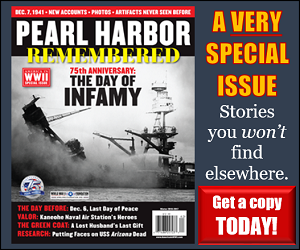Every photograph has its story to tell. But few capture a moment as fully as this US Navy photo from the Pearl Harbor attack does.
By Jim Kushlan
Note: The numbers below correspond to arrows on the labelled version of the photo, below.
1. You’re standing on Pearl Harbor’s Ford Island, home to a naval air station and mooring point for much of the US Navy’s Pacific Fleet. You’re at the fleet landing area, where launches from the mighty warships tie up to load and unload people and supplies. It’s Sunday morning. It should be calm, quiet, even leisurely. Instead, everything is chaos, motion, smoke, noise, and terror. And you’re in the middle of it.
2. You’re waiting to catch the line from a launch coming in on your right, manned by battle-shocked sailors in their underwear. They’re bringing casualties from the navy’s first mass attack by Imperial Japanese carrier planes. Enemy aircraft came roaring over Pearl Harbor without warning just before 8 a.m., unleashing hellfire in the form of aerial torpedoes and bombs. The surprise was absolute. The results were devastating.
3. To your left, smoke is rising from USS California (BB-44), tied to a mooring quay at the southern end of Battleship Row, where most of the Pacific Fleet’s deep-draft battleships are moored in two neat rows. California, the fleet’s flagship, has taken torpedo and bomb hits. She’s listing to port and taking on water, but smoky fires on board have forced the crew to stop pumping out the inflowing water (note the smoke curling out from the bridge). The ship is sinking slowly but surely.
4. Straight ahead of you, farther up Battleship Row, USS Maryland (BB-46) is holding her own, her guns blazing away at enemy dive bombers. 5. But next to her, a whitish wedge protrudes from the water—the keel of USS Oklahoma (BB-37), which has capsized, sunk by aerial torpedoes. Many Oklahoma crewmen have climbed aboard Maryland to help man her guns and fight back. 6. More launches like the one you’re assisting are on their way from Oklahoma and beyond, working hard and fast to save lives.
7. Still farther back on Battleship Row, USS Arizona (BB-39) is hidden from view by the ships in front of her. But a thick column of black oily smoke billowing from the dying battleship pinpoints her position. Struck by a Japanese bomb, Arizona’s forward magazines blew apart in a violent explosion that killed most of the crew. The ship sank, burning uncontrollably.
8. Ahead of Arizona, just past Maryland and sitting low in the water, you see USS West Virginia (BB-48). She too has sunk, though timely counter-flooding kept her upright and level as her keel settled onto the bottom. More than 1,700 sailors and marines from Arizona, West Virginia, and Oklahoma alone are dead.
9. Far to your right, you see another ship—fleet oiler USS Neosho (AO-23)—backing away from the attack area, firing at Japanese planes all the way. Fortunately, she unloaded her cargo of airplane fuel on Ford Island the day before. Otherwise she would have been a floating bomb.
As you help unload mangled, bloodied, and burned men from the launch in front of you, you’re not sure you won’t be a casualty yourself. 10. Planes and buildings are burning behind you on Ford Island. No one knows what’s going to happen next. But you stay at your post, you keep doing your duty. You feel surges of anger, fear, worry—and a fierce determination to make Japan pay for this savage attack.
The people and events of this pivotal moment in history—over 75 years ago—are what America in WWII’s 120-page special issue PEARL HARBOR REMEMBERED is all about. We invite you to keep the memory alive. Click here for more info, or to order.





FOLLOW US »
